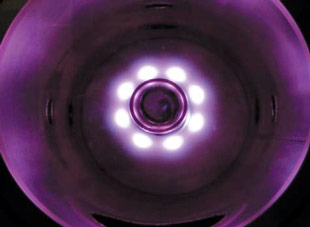| 2005 |

|
YEAR BOOK |
Dublin City University
|
Plasmoids in an inductively coupled plasma
|

Here at the National Centre for Plasma Science and Technology (NCPST) we carry out research into a particular type of rf discharge known as an inductively coupled plasma (ICP), which is used extensively in the semiconductor industry. An ICP uses a radiofrequency antenna to radiate electromagnetic waves into a vacuum discharge chamber. Free electrons are accelerated in the gas causing the ionising collisions. An essential feature of this type of discharge in relation to semiconductor processing is plasma uniformity. If the plasma exhibits non uniformities or instabilities then the processed batch may have defects affecting the entire production line.
A particular type of instability exhibited in ICP discharges is the phenomenon of plasmoids. These are gross spatial instabilities observed as bright lobes of dense plasma within the discharge. They can be made to 'dance' around the discharge changing in size, number and even colour, depending on the plasma discharge conditions. Although aesthetically pleasing they are detrimental to any discharge requiring uniformity. This type of instability has been observed in various types of discharges since the 1930s, however as yet, no satisfactory explanation has been given to their formation.
At the NCPST we have been carrying out experimental and theoretical work to explain this aesthetically pleasing, yet ultimately undesirable phenomenon.
Contact: Angus McCarter, NCPST,
Dublin City University, Glasnevin, Dublin 9;
E-mail: [email protected]